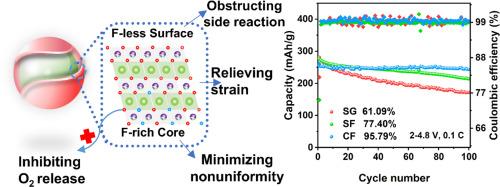Boosting reaction homogeneity through reverse gradient fluorination for high-performance Li-rich layered cathodes
IF 20.2
1区 材料科学
Q1 CHEMISTRY, PHYSICAL
引用次数: 0
Abstract
Co-free lithium-rich cathode materials (LRMNO) demonstrate advantages in capacity and cost, however, a continuous decline in specific capacity during cycling, impedes their commercialization in Li-ion batteries. Ultimately, irreversible anion redox and cumulative bulk strain induce structural instability in the LRMNO cathode. The performance can be enhanced through partial fluorine substitution in oxygen, which adjusts the redox contributions of anions and cations. Nevertheless, the effectiveness of surface F substitution for practical applications remains limited due to the low solubility of F in the cathode material and its modest effect on the bulk lattice. In this study, a new Li1.2Mn0.6Ni0.2O2 cathode featuring a reverse F concentration gradient (with F increasing linearly from the particle center to the surface) by a secondary sol-gel method was presented, for tailored the effects of fluoridation at varying depths. The gradient-engineered sample demonstrated improved cycle stability and enhanced rate performance, achieving a capacity retention of 95.79 % after 100 cycles at 25 mA g–1. These significant enhancements result from reducing the capacity contribution from the less reversible oxygen redox, optimizing bulk strain, and suppressing side reactions. This research proposes a universal strategy to effectively tackle challenges related to heterogeneous lithium-ion transport processes and asynchronous multiredox reactions, particularly for foreign elements with low solubility and prone to passivation layers, thereby mitigating performance degradation.


通过反梯度氟化提高高性能富锂层状阴极的反应均匀性
无钴富锂正极材料(LRMNO)在容量和成本方面具有优势,然而,循环过程中比容量的持续下降阻碍了其在锂离子电池中的商业化。最终,不可逆阴离子氧化还原和累积体应变导致LRMNO阴极结构不稳定。通过氟在氧中的部分取代,可以调节阴离子和阳离子的氧化还原贡献,从而提高性能。然而,由于F在正极材料中的溶解度低,对体晶格的影响不大,表面F替代在实际应用中的有效性仍然有限。本研究采用二次溶胶-凝胶法制备了一种具有反F浓度梯度(F从颗粒中心到表面线性增加)的新型Li1.2Mn0.6Ni0.2O2阴极,以适应不同深度氟化的影响。梯度工程样品表现出更好的循环稳定性和增强的速率性能,在25 mA g-1下循环100次后,容量保持率达到95.79%。这些显著的增强是由于减少了不可逆氧氧化还原的容量贡献,优化了体应变,抑制了副反应。本研究提出了一种通用策略,以有效解决与非均相锂离子传输过程和异步多氧化还原反应相关的挑战,特别是对于溶解度低且易于钝化层的外来元素,从而减轻性能下降。
本文章由计算机程序翻译,如有差异,请以英文原文为准。
求助全文
约1分钟内获得全文
求助全文
来源期刊

Energy Storage Materials
Materials Science-General Materials Science
CiteScore
33.00
自引率
5.90%
发文量
652
审稿时长
27 days
期刊介绍:
Energy Storage Materials is a global interdisciplinary journal dedicated to sharing scientific and technological advancements in materials and devices for advanced energy storage and related energy conversion, such as in metal-O2 batteries. The journal features comprehensive research articles, including full papers and short communications, as well as authoritative feature articles and reviews by leading experts in the field.
Energy Storage Materials covers a wide range of topics, including the synthesis, fabrication, structure, properties, performance, and technological applications of energy storage materials. Additionally, the journal explores strategies, policies, and developments in the field of energy storage materials and devices for sustainable energy.
Published papers are selected based on their scientific and technological significance, their ability to provide valuable new knowledge, and their relevance to the international research community.
 求助内容:
求助内容: 应助结果提醒方式:
应助结果提醒方式:


